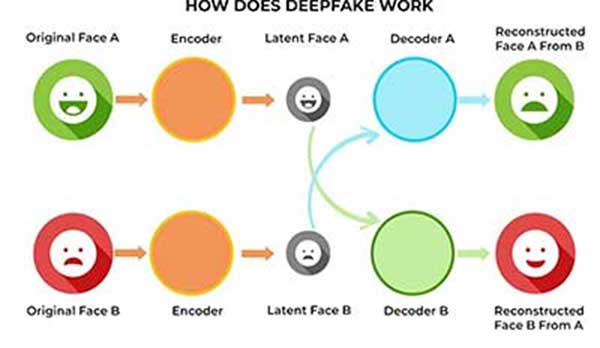Date : 06/06/2023
Relevance: GS Paper 3 : Role of Media and Social Networking Sites in Internal Security Challenges
Main Words : Public trust, Privacy, Misinformation, Fake News
Context-
Recently wrestlers protesting peacefully in New Delhi were arrested, and boarded in a van to keep them from disrupting the inauguration of the Parliament building. Shortly after, a photo appeared to show four of the beleaguered wrestlers posing with wide smiles for a selfie in the van.Though it emerged later that this photo had been morphed.
What is Deep Fake?
Deepfakes, which are artificially manipulated media content created using deep learning, pose a significant challenge in distorting reality and spreading misinformation. While they surpass traditional image editing techniques like Photoshop, deepfakes have the potential to deceive viewers into believing false narratives. As technology advances, the need to effectively tackle deepfakes becomes imperative to safeguard against their misuse.
The Rising Influence of Deepfakes:
- Deepfakes, powered by machine learning, can generate convincing fake images and videos with fewer imperfections than traditional methods. This technology has already been exploited for various malicious purposes, such as creating fake videos of prominent figures engaging in inappropriate behavior or spreading false information.For example People worldwide have already used the technology to create a video of Barack Obama verbally abusing Donald Trump.
- The first case of malicious use of deepfake was detected in pornography.It reduces women to sexual objects causing emotional distress.
- Leaders may weaponise deepfakes and use fake news and alternative-facts narrative to dismiss an actual piece of media and truth. (liar’s dividend)
- These deepfakes can manipulate public opinion, evade facial recognition systems, and even facilitate the creation of non-consensual explicit content.
- Instances like the dissemination of a deepfake image showing a fabricated explosion at the Pentagon demonstrate the alarming impact of deepfakes. The ease with which such deceptive content can be created raises concerns about the integrity of information in the digital age.
- Furthermore, the integration of chatbots and AI-powered systems blurs the line between human and machine-generated content, making it difficult to distinguish between authentic and fabricated information.
Balancing Potential Misuse and Positive Applications:
While deepfakes present considerable challenges, they also offer potential positive applications.
- Organizations like the ALS Association leverage deep learning to restore the voices of individuals affected by diseases like ALS (Amyotrophic lateral sclerosis ).
- Additionally, the technology has been utilized in entertainment fields, enabling the recreation of historical figures and enhancing our understanding of the past.
- However, controversy surrounding such applications highlights the need for responsible use and ethical considerations.
Regulating Deepfakes:
- Promoting Media Literacy: Strengthening media literacy initiatives is crucial to empower the public with the ability to discern credible information.
- Establishing Collaborative Regulatory Mechanisms: It is essential to foster meaningful collaboration and discussions involving the technology industry, civil society, and policymakers to develop legislative solutions that discourage the creation and dissemination of malicious deepfakes. By working together, a comprehensive regulatory framework can be established.
- Advancing Detection Technology: Social media platforms have started acknowledging the threat posed by deepfakes, with many implementing policies and acceptable terms of use regarding their presence. However, we also need user-friendly and accessible technology solutions that can detect deepfakes, authenticate media, and amplify authoritative sources.
- Conducting Mass Awareness Campaigns against Deepfakes: To effectively address the issue of deepfakes, it is imperative that each individual takes responsibility by becoming critical consumers of online media. Before sharing content on social media, it is important to pause, think, and verify its authenticity. By actively participating in the fight against this "infodemic," we can collectively counter the menace of deepfakes.
Global Scenario
- China: China has introduced a new policy that mandates service providers and users to ensure explicit labeling of doctored content created using deepfake technology. Additionally, the policy requires the ability to trace back such content to its original source.
- The European Union: The European Union has implemented an updated Code of Practice that places responsibility on tech giants like Google, Meta (formerly Facebook), and Twitter to take proactive measures in countering deepfakes on their platforms. Failure to comply with these measures can result in fines up to 6% of their annual global turnover.
- The United States: In the United States, the bipartisan Deepfake Task Force Act has been proposed to aid the Department of Homeland Security (DHS) in combating deepfake technology. The act calls for an annual study on deepfakes to be conducted by the DHS.
- India: Currently, there are no specific legal regulations in India targeting the use of deepfake technology. However, existing laws, such as those related to Copyright Violation, Defamation, and cybercrimes, can be applied to address misuse of this technology.
Conclusion:
Deepfakes represent a significant challenge in the digital era, distorting reality and spreading misinformation. While their potential for misuse is evident, deepfakes also offer beneficial applications in various fields. To effectively address this issue, a balanced approach is required, involving regulations that punish bad actors, protect individuals' rights, and allow democratic inputs to shape the future of deepfake technology. Additionally, fostering digital literacy and personal accountability is crucial to empower individuals in recognizing and combatting deepfakes. Only by collectively addressing these challenges can we mitigate the negative impact of deepfakes and safeguard the integrity of information in our society.
Probable Questions for Main Exam-
- Question 1: Deep Fake technology has both positive and negative applications. Discuss the potential benefits of deep Fake, such as voice cloning and historical recreations, and the ethical considerations surrounding their use. (10 Marks, 150 Words)
- Question 2: Assess the role of media organizations and social media platforms in combating the spread of deepfakes. How can these entities develop effective mechanisms to verify and flag manipulated content while ensuring freedom of expression? (15 Marks,250 Words)
Source: The Hindu







